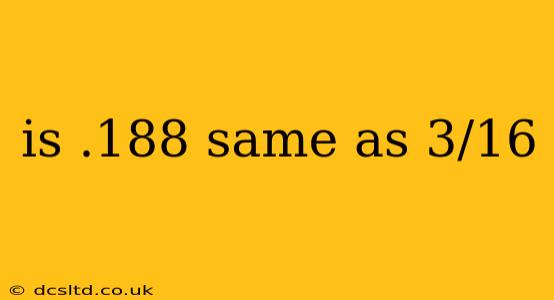The question of whether 0.188 is the same as 3/16 is a common one, particularly for those working with measurements or calculations involving both decimals and fractions. The short answer is: almost, but not exactly. Let's delve into why.
Converting Fractions to Decimals
To determine if these two values are equivalent, we need to convert one to the form of the other. The easiest approach here is converting the fraction 3/16 into a decimal. We do this by dividing the numerator (3) by the denominator (16):
3 ÷ 16 = 0.1875
Comparing the Values
Now we can compare the decimal representations:
- 0.188
- 0.1875
The difference between 0.188 and 0.1875 is 0.0005. While this difference is very small, it's still significant enough to declare them not precisely equal. In many practical applications, the difference might be negligible and you could consider them effectively the same. However, for precise calculations, the discrepancy matters.
Why the Slight Difference?
The difference arises from the inherent limitations of representing fractions as decimals. Some fractions, like 3/16, result in terminating decimals (decimals that end), but the decimal representation might require more digits than initially used (0.1875). Rounding 0.1875 to three decimal places gives us 0.188, which is an approximation.
Are 0.188 and 3/16 close enough?
The closeness of 0.188 and 3/16 depends entirely on the context. In applications where high precision is not required (e.g., some carpentry or basic measurements), the difference is likely insignificant. However, in engineering, scientific calculations, or financial contexts, this small difference could lead to errors, so precise representation (0.1875) is necessary.
How to Handle Decimal and Fraction Conversions
When working with both decimals and fractions, remember these key points:
- Understand the context: Determine the level of precision needed for your application.
- Use the appropriate tools: Calculators or software can help with accurate conversions.
- Be aware of rounding errors: Rounding can introduce small inaccuracies. If precision is paramount, avoid unnecessary rounding.
- Choose the most suitable format: Depending on the task, one format might be more convenient or efficient than the other.
By understanding the nuances of decimal and fraction conversions, you can avoid potential inaccuracies and ensure the precision needed for your specific applications.
